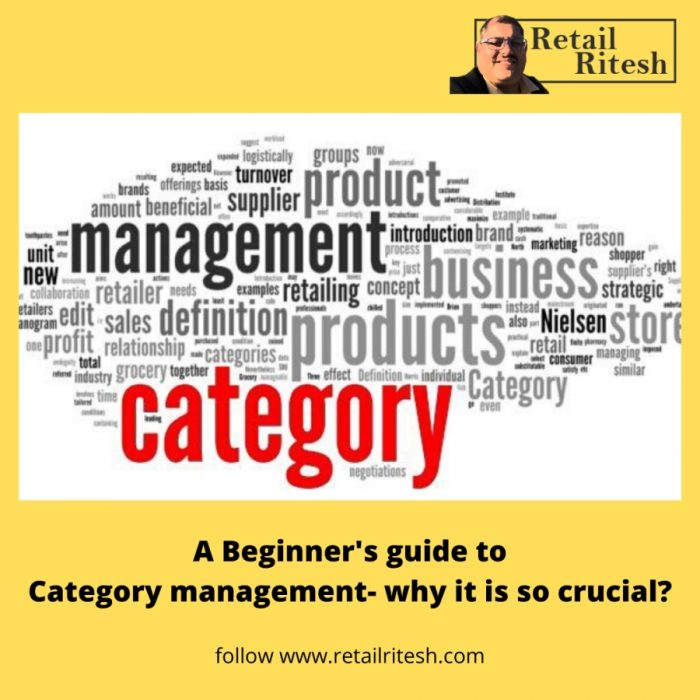A Beginner’s guide to Category management- Why is it so crucial?
A Beginner’s guide to Category management.
Category management, the term arises from hypermarket or modern trade retail management practices.
It signifies the importance assigned to a particular category from the Profit & loss point of view. It brings the feeling of collaboration amongst the buyers and vendors.
Collaboration with vendors in terms of exchange of information, sharing of data and joint business building.
The focus of all supplier negotiations is the effect on the turnover of the category as a whole, not just the sales of individual products.
Suppliers are expected, indeed in many cases mandated, to only suggest new product introductions, a new planogram or promotional activity if it is expected to have a beneficial effect on the turnover or profit of the total category and be beneficial to the shoppers of that category.
Category management is a retail management tool in developing a category as a profit center.
What is the category?

Firstly let’s understand what is a category, a category is essentially any group of similar items that the company wishes to buy under a single deal. The management part is about applying procurement methodologies to ensure the firm maximizes savings.
The central driver behind category management is to simplify demand and take a bigger contract to the market. The greater the scale, the lower the unit price.
Let me explain using an easy category management example:
If you are a store chain having 10 stores and each store buys sanitizers (nowadays hot selling item), from different vendors; Imagine the time spent by individual stores in negotiating, etc. There is a higher probability of non-uniformity in the purchase prices as well.
To streamline the procurement process, the companies approach the vendor with their centralized purchase order to ensure purchase prices are locked at the beginning of the year for that category or items at a group level which results in uniformity in purchase prices.
The savings for the above example of sanitizers are clear. If we extrapolate this case to more important business activities, such as industrial products or technology, the savings available to organizations are huge.
This is category management.
The process of clustering and centralizing similar goods into bigger contracts which are easier to administer and lowers prices.
Learn how covid-19 is impacting the retail sector, read here.
What is Category Management?
As explained in the previous examples, companies especially, large hypermarkets, chain stores, ensure that they are procuring goods in their categories at the lowest cost and hence they can provide a Value proposition to their customers, who buy from these hypermarkets on their price deals promise.
How does one implement the Category management process in their organizations?
By following these steps, one can implement category management in procurement.
- Identify category items or opportunity drivers:
Identify items that you would like to control based on historical sales and its impact on your bottom-line i.e. % contribution of that category on your net sales.
- Formalizing Category strategy
Consolidating internal needs and external capability, buyers must determine which sourcing methods will best position the company in the market.
- Develop RFQs (request for quotations) forms and screen out the suppliers.
- Work out evaluation parameters or vendor checklist
- Invite online RFQs or bidding from the suppliers.
- Negotiate and firm up your contract
Once bids have been received, the company has an opportunity to further shape the offering to add more value. This is a key step where a category manager can contribute to the process, through mobilizing knowledge of the business and identifying.
- Vendor onboarding process management.
Once the vendor is selected and contract signed it is the category manager’s responsibility to conduct vendor onboarding so that the supply chain processes are adhered to by the vendor including QC (quality checks and audits).
What are the Benefits of Category Management?
- Centralizing Spend Data (helps in managing OTB)
- Opportunities for Cost Savings
- Better Vendor Risk Management
- Better cash flow planning and credit limits.
Any business benefits a lot from adopting category management as one of its best practices in procurement.
An organization can tap into opportunities to manage demand, have better cash flow management, and enforce greater compliance of standards from suppliers.
Category management can break or make a retail chain store.
Customer or a shopper has to be the central component of category management strategy.
Put yourself into the customer’s shoes and ask the following questions before formalizing your strategy.
- How does the shopper shop?
- When do they make their purchase decisions?
- Why do they make their purchase decisions?
- What factors influence or motivate their decision?
- Who decides to purchase?
- When & Where is the purchase decision made?
- How much is bought / would they buy more if incentivized?
- What else did / would they buy? (your opportunity for cross-selling or bundling)
- How did they feel about the purchase experience?
Learn the art of bundling, read here.
How to do category planning by breaking it into components of category management?
The most practical way is to divide your store into zoning
Zoning i.e. which section gets more traffic ( I am taking an example of beauty & cosmetics store) and how they need to categorize their zoning & develop growth strategies.
- Fragrances
- Skincare
- Cosmetic
- Gifting section
- Make me look gorgeous ( experiential zone)
- Buy me NOW (promo section)
| Category | Strategic impact on store P&L | Group category |
| Fragrances | traffic building | Destination |
| destination image building | ||
| creating excitement | ||
| Transactional building. | ||
| Skincare | traffic building | Routine / convenience |
| destination image building | ||
| Promoting wellness skincare regime | ||
| Transactional building. | ||
| Cosmetics | traffic building through unique brands | Destination/ convenience |
| destination image building | ||
| Promoting fashionable and vanity quotient | ||
| Transactional building. | ||
| Giftings | builds image | Seasonal |
| transactional building | ||
| Experiential zone | Brand turf protecting | Destination & convenience |
| drives traffic | ||
| drives customer engagement | ||
| develops and builds customers loyalty | ||
| drives social media user-generated content. | ||
| Promo section | Traffic builder | Routine |
| transactional building tool | ||
| (always some deals to grab – Tjmaxx uses this concept) |
Learn how TJ Max is defying all recessionary pressures, click here.
I hope my article on category management and its importance will help Brand managers and key account managers to develop their categories more profitable. I shall write more about category management for the benefit of my readers who are handling supermarkets and modern trade.
If any of my readers want to reach out to me then please feel free to write to me on riteshmohan@yahoo.com
References: grocer.com.uk, whatis.com, Retail management by Prof Piyush Sinha, shelfstock.ie
About the Author:
Ritesh Mohan is a passionate retail professional with over 20 years in the Retail sector, handling some of the biggest brands in beauty, fashion and fragrances retail & FMCG sector. Ritesh has been instrumental in the growth of some of the regional brands as well in the Middle East region. He specializes in Retail management, Product development, and Brand Management, Retail Operations, Sales Management and Franchising & Business Management. He strongly believes in empowering business owners with his wisdom & experience of around two decades in the industry.






3 Myth-busters of modern grocery retail or hypermarket retail. - Retail Ritesh
May 9, 2020 @ 1:54 pm
[…] learn about category management, click here. […]
Fit- tech revolutionizing fashion retail? Learn now - Simplifying retail
March 3, 2023 @ 2:14 pm
[…] To learn about Category management, click here. […]